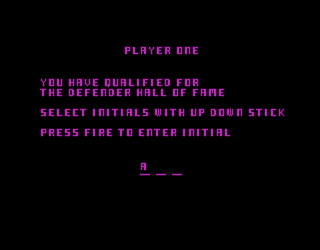
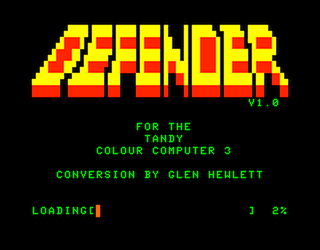
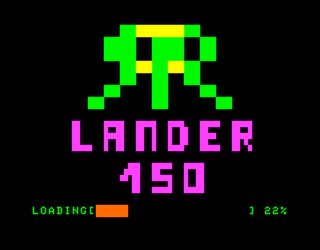
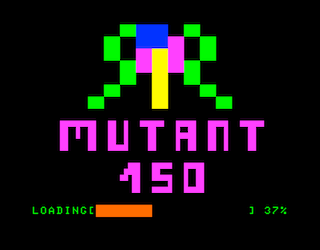
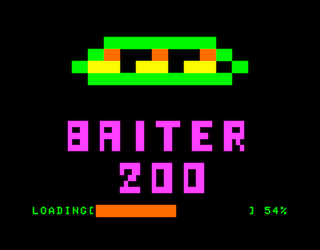
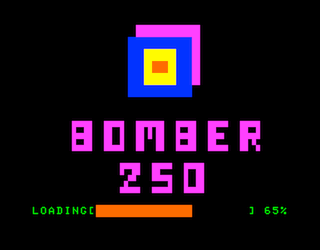
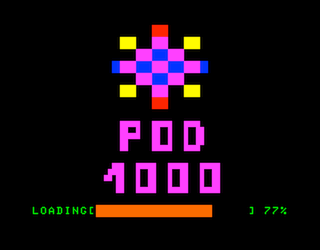
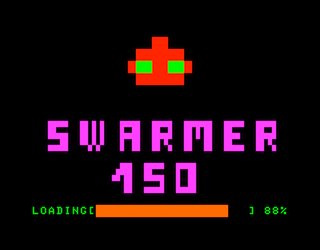
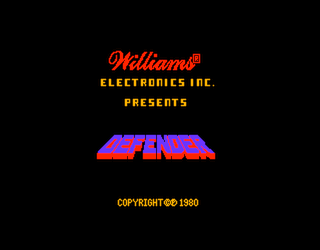
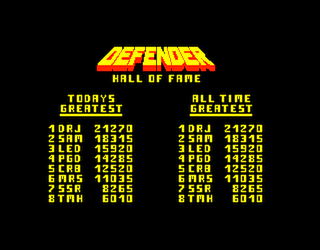
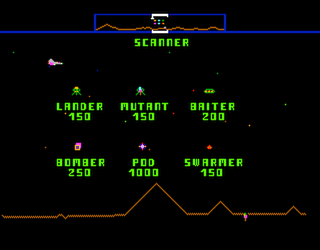
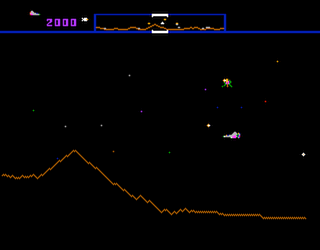
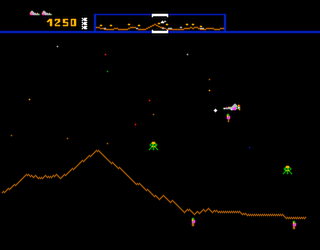
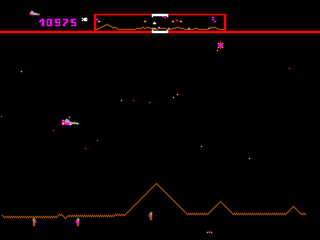
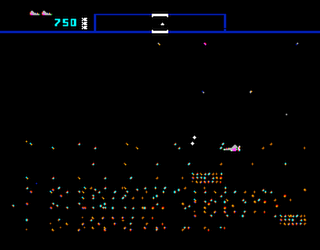

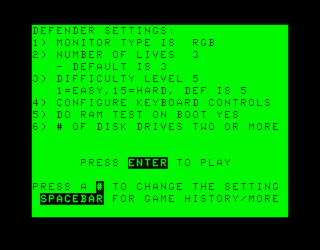

Defender is a conversion of the official Williams Defender game from the arcades which was originally written in 1980 (and released in early 1981). This conversion is even more ambitious then Glen Hewlett's previous Joust conversion from just a month earlier, as the screen can get a lot busier and it has more sound effects, which is why Defender takes 2 disks. The arcade original was a huge smash (being one of the highest grossing arcade games ever), but with a higher difficulty level than a lot of other arcade games at the time (somewhat due to the number of controls; there was a vertical only joystick for moving up and down, and a Reverse button to switch the ships direction left and right, all controlled by the player's left hand. The right hand was kept busy with Thrust, Fire and Smartbomb, and there was an emergency Hyperspace button in the middle for whichever hand could hit it first). Like Joust, the arcade original in this case also used the 6809 CPU chip (same as the Coco 3), making the conversion somewhat easier and faster to develop. However, the sound on the arcade original were controlled by a second 6808 CPU (which is based on the 6802), which had it's own ROM's containing 8 bit DAC audio samples, triggered by single byte signal codes sent by the main CPU. Glen duplicated this functionality all based on the GIME programmable timer interrupts and raw sound samples.
In order to try and maintain the "feel" of the arcade original, the game is completely played on keyboard (there are not enough buttons on regular or deluxe joysticks to not make it awkward to try and hit the various buttons during gameplay, which in Defender is intense. To help players, Glen does have the keys completely configurable (as is the monitor type, difficulty level, # of lives, enabling/disabling the original ROM's RAM test, and the option of using 2 disk drives to more rapidly load the game without swapping disks) through a config program. The Insert coin and 1 or 2 player selection keys match Joust's usage of the MAME standard (5 for insert coin), and the game play keys are defaulted quite well for a Coco 3 physical keyboard. You will likely have to change them to be more comfortable with an emulator, though. As with Joust, you can also BREAK out of the game, and then run the SAVE program to save the high score tables (although a bug in MAME at this writing causes the machine to freeze; a fix has been submitted and should be out soon).
There is currently a couple of places that the sound slows down a little bit (the insert coin sound and the initial "start of a new game" sound in particular), but it doesn't affect the gameplay, and the main game itself doesn't seem to slow down any more than the arcade original did (and even it could get overtaxed at times, having special routines to help try and alleviate that). For those that have not played Defender before, the object is to destroy 6 different types of aliens while protecting your human colony (10 people at the start). An alien called a Lander will try to snatch the humans (you can shoot them and then try and catch the human before it falls to the ground (dying if it falls too far); if it makes it to the top of the screen, the human gets merged with the alien and becomes a mutant which is much more aggressive towards the player. If all of your humans die, the game doesn't end; instead, a (very spectacular for the time) massive explosion destroys the entire planet you are flying over, and every remaining lander turns into a mutant. If you can survive long enough, you can get your planet (and some humans) back every 5 waves.
Each alien has it's own specialty making for very varied game play and intense, constant action. There is also a radar at the top of the screen that shows the entire world, including the mountain ranges, all aliens, and even where your humans are. The subtle nuances of the arcade are all present, including the "International Date Line" (where aliens that are tracking towards you suddenly turn around and fly the opposite direction to come at you from the other side), and being able to prevent the planet from blowing up by carrying a human for an entire level, even if none are left on the ground.
Glen also added his own nuances to the game as well; since the game has to fully load (and then decompress) two disks, rather than just have a progress meter like he did in Joust, he actually displays a low res graphic version of all 6 opponents (with their names and point values) as the game is loading. I will mention that I am going to try and help Glen to see if we can fix up the few sound slowdowns, when both of us have time to do so. This game is really pressing what a 512K 6809 based Coco 3 can do, and is one of the most ambitious conversions done to date on the Coco 3.
Title: Defender
Author: Glen Hewlett, based on original arcade 6809/6808 code by Eugene Jarvis. ZXO compressor by Einar Saukas, 6809 Decompressor by Doug Masten.
Publisher: Glen Hewlett
Released: September 25, 2021
Requires: Color Computer 3, 512K RAM.